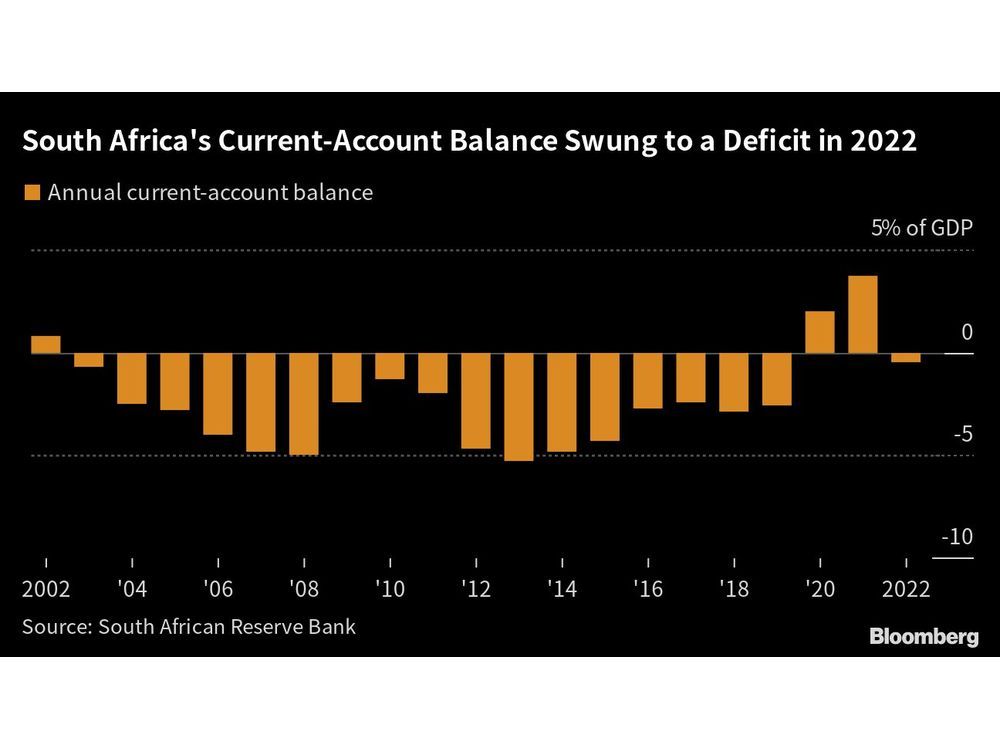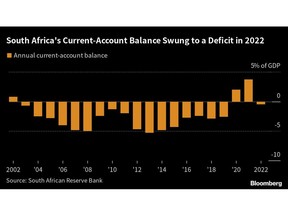South Africa Posts First Current-Account Deficit in Three Years

South Africa posted a current-account deficit for the first time in three years in 2022 as imports increased and power shortages and logistics—network constraints curbed exports, heightening the nation’s vulnerability to external shocks.

Article content
(Bloomberg) — South Africa posted a current-account deficit for the first time in three years in 2022 as imports increased and power shortages and logistics—network constraints curbed exports, heightening the nation’s vulnerability to external shocks.
Advertisement 2
Article content
The balance on the current account, the broadest measure of trade in goods and services, swung to a deficit of 0.5% of gross domestic product, or 31.8 billion rand ($1.7 billion), from a surplus of 3.7% in 2021, the South African Reserve Bank said in a report published Thursday. It’s the first annual shortfall since 2019 and comes after coronavirus restrictions and global supply-chain disruptions suppressed imports.
Article content
The current-account gap and the budget shortfall, which the Treasury sees narrowing to 4% of GDP in the fiscal year through March 2024, make South Africa vulnerable to external shocks amid deteriorating global economic prospects. In January, the World Bank cut its growth forecasts for most countries and regions, and warned that new adverse shocks could tip the global economy into a recession.
Article content
Advertisement 3
Article content
The current-account balance in the fourth quarter was an annualized shortfall of 2.6% of GDP, or 174 billion rand, compared with an upwardly revised surplus of 3.1 billion rand in the previous three months. The median of nine economists’ estimates in a Bloomberg survey was for a negative balance of 2.5% of GDP.
South Africa’s economy contracted by 1.3% in the fourth quarter, with statistics agency data showing intense rolling blackouts and declines in mining activity and exports curtailing output growth. Eskom Holdings SOC Ltd. subjected the country to power cuts, known locally as loadshedding, on all but three days during the quarter, while disruptions at fellow state-owned company Transnet SOC Ltd.’s aging rail network and ports affected shipments of key commodities.
Advertisement 4
Article content
The impact of rolling blackouts and logistics infrastructure shortfalls were partially countered by the first coronavirus-restriction free summer holiday season. The deficit on the services account, under which income from tourism falls, narrowed to 85 billion rand in the fourth quarter, from 108 billion in the previous three-month period. December is traditionally the most popular holiday month in South Africa.
The central bank’s quarterly projection model in January shows it expects a current-account gap of 1.7% of GDP in 2023. The current-account balance is expected to deteriorate over the short- to medium-term due to continued electricity-supply constraints, increased investments in alternative energy solutions that will drive up imports, and a projected decline in export volumes, Governor Lesetja Kganyago said in a speech posted on the Reserve Bank’s website Tuesday.
Share this news on your Fb,Twitter and Whatsapp
Times News Express:Latest News Headlines
Times News Express||Health||New York||USA News||Technology||World News


Comments
Postmedia is committed to maintaining a lively but civil forum for discussion and encourage all readers to share their views on our articles. Comments may take up to an hour for moderation before appearing on the site. We ask you to keep your comments relevant and respectful. We have enabled email notifications—you will now receive an email if you receive a reply to your comment, there is an update to a comment thread you follow or if a user you follow comments. Visit our Community Guidelines for more information and details on how to adjust your email settings.
Join the Conversation